First I want to thank all contributors to this topic for sharing this information. This know how is so important to keep our birds healthy and in good breeding condition.
Note that we in Europe do have a great responsibility to keep our birds in top condition because there are no incoming birds anymore.
That is why we are very keen on gathering all kind off information to gain an optimal result.
We (my wife is also a bird lover) keep a verity off soft bills some Bulbuls
laughing thrushes and also some thrushes among them the Shama and they really stole my hart.
Because of the import restrictions we think its wise to specialice.
We intend to specialise in the Shama.
We keep all our birds in couples in seperated aviaris size depends between 4'by 9'height 8' these are the small ones. till 8'by 9'height 8'
the bigger ones.
Than there is also the Royal suite this is a tropical greenhouse 8'by 10' H
7 feet with an aviary 8'by 10' height 13' their is a peach tree in it .
I am just about to finish 3 more aviary's when they are completed we have a total off 18 separated breeding flights.
Because our garden is located next to a forest and a low cat rate in the neighbourhood we can let our birds fly freely in our garden when they have chicks a wonderful site it's to us the optimal way of bird keeping.
Our garden during Summer season

This is the most dare photo of my live (Till now) you call this bird the Piang Piang.
For as far as I know I'm the only one breeding with this bird in Europe.
This photo is called: Friends for live.
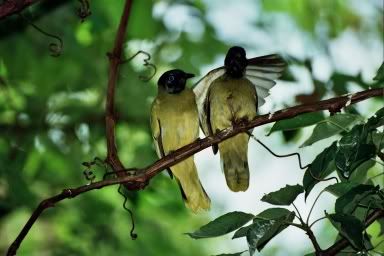
Just some photo's of our birds flying an being free in our garden

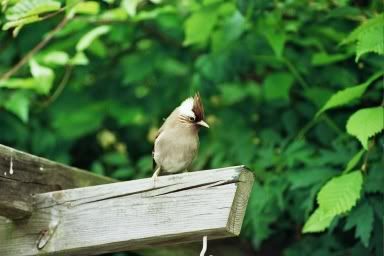

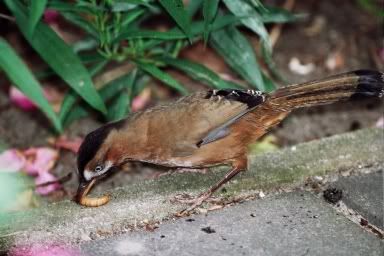
Now back to the Shama.
This is beauty now in my care for 14 month his tail increased at least 2" since the last molt due to better feeding but I think I can do better.
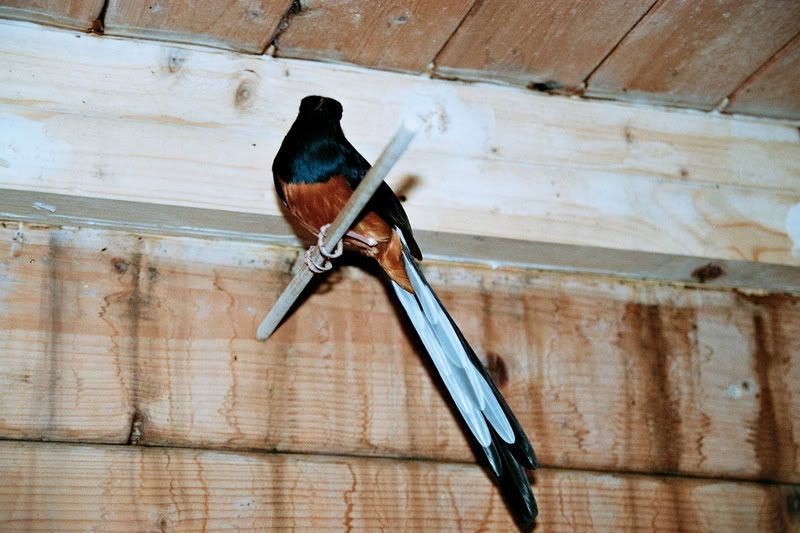

In Holland we have something you lack. ( Thank God for that) It's called winter. Cold sometimes freezing which means no insects and although
we have our Shama,s on a diet of mealworms and crickets there might be a form off food deficiency.
And now I have a question for the real experts.
Considering Beauty's tail long white feathers and than 4 I would say withholding black ones.
Lately I came to the idea could it be that because the molt takes place during fall lesser sun lesser insects decreasing temperature that that is the reason the primary feathers stop to grow.
I know the last question is out off your league because you don't have that problem.
My question to you is regarding the white tail feathers and the prescribed
situation. Could there be a surprise for us if I optimised his condition means
Royal suite LOL.
Another question is their anybody looking at Beauty and Pearl who can say where they come from.
Both birds are breaded in Holland but where are there parents come from?
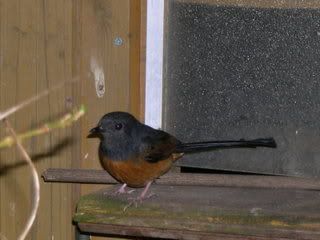
I think they are coming from Thailand. Copsychus malabaricus mallopercnus but I’ not sure.
One note considered feeding Earthworms to your birds.
And I noted that the Earthworm was considered several times as an excellent food for Shama's
In Holland it's not done due a disease the worms are wearing but this is the other site off the world so it will take some time till it appears in Malaysia but there is also an other problem considered the earthworm crawling through the soil needs a lot off energy and a lot of oxygen what needs a lot off ion (ferro) in the blood cells.
Ferro is lethal to lots off soft bills causing an increased liver and in time the death of your beloved bird.
You can see for yourself at a link David ( The one and only) ( He has no idea how known he is in the world) it was on this thread off Oct. 13 2006
http://www.nagonline.net/Technical%20Papers/NAGFS00397Insects-JONIFEB24,2002MODIFIED.pdf
at page 5 you can see the amount off Ferro (Fe) Ion in the
Earthworm 4113 ppm
mealworm larvae 43 ppm
Cricket domestic 80 ppm
So one Earthworm contains the same a mouth off Ion than 100 mealworms.
We are looking forwards to your reply's
Below is a post written on Jan 16, 2007 in response to a post from Holland
Hi Arjan, May I first congratulate you and your wife on your beautiful birds and garden. It is obvious that a great deal of love and effort went into their care. It's wonderful to be able to have the birds flying free. This is something we in Singapore can only dream about as we live in a city and even for those with gardens, there is the danger to the birds from cats and sometimes crows.
The threat of the bird flu has also affected the import of birds into Singapore. Indonesia recorded 2 human deaths from bird flu just last week. There is a ban on the import of poultry and birds to Singapore from neighboring countries. This is a pity as there has recently been an increase in interest in keeping shamas.
Feeding and Molt
If you cannot provide a variety of insects during the winter why not provide fish, minced meat, hard-boiled egg and frozen ants eggs. I mentioned to my friend Axel once that immature guppies are a very good food and he told me with a laugh "These are ornamental fish, do you know how much they cost?" Perhaps, but this fish breeds readily and rapidly and if the lowest quality in terms of beauty is procured the cost may be manageable.
When feeding guppies to the shama, the fish should be placed in a cup or tray with the water just covering their backs. This makes it easy for the birds to get them. Surprisingly, the guppies also do better with less water. You probably know this but others may find it helpful - if ants' eggs are obtained and frozen before the winter, there will be a ready supply of fresh food to supplement the insects. I separate the fresh ants' eggs into small packets and place them in the freezer as soon as I get them. I then remove 1 packet at a time and apportion it amongst my birds.
I know that too much beef is not good for the birds because of the high phosphorous or potassium content, but a little minced beef or chicken, about the size of a small shama egg, fed to the birds once or twice a week, seems to be good for them. The first warden of the Jurong Bird Park, Singapore whom I know very well used to feed minced beef and hard boiled eggs to his shamas and I have never seen healthier birds. His shamas might get a little minced beef once or twice a week and a very small piece of hard boiled egg yolk also once or twice a week, on those days when beef was not fed.
Looking at Beauty's tails in the photo, my first impression was that he had not completed his molt and his long (primary) tails are still growing. I say this because the photos show that his primary tails are only about an inch longer than the secondary black tails. This is unusual if the tails are fully grown. He has very long white tail feathers and secondary black tails. Accordingly, I would expect the primary tails to be longer than the secondary black tails by at least 3 inches. In fact, the appearance of the primary tails suggests that they stopped growing prematurely. I am not sure of the cause since the nutrition must be good as there is a shine on his feathers and I do not see stress lines on his tails which could indicate that there is something wrong with the feeding.
My guess is that Beauty's tails should have the potential to grow to at least 10". You might want to try the following suggestions to see if it will increase his tail length. First and foremost, since the feathers are largely made up of protein, a good high quality protein food should be consistently and daily provided. The food should be supplemented with vitamins and minerals to aid feather growth.
The vitamins that I have found to be most important during the molt are B Complex and E. The B Complex is necessary for protein digestion and the E also aids the molt. In instances where there has been a deficiency of vitamin B, I have found that the bird eats less and this has an adverse effect on tail length. The vitamin E in oil form is preferable as it gives a sheen to the feathers.
On the question of whether the cold weather could have an adverse effect on the molt my answer must of course be that this is a possibility. However, there may be a more likely cause. As you know, the shama needs to consume much more food during the molt. I find that if I leave the light on for them they will continue eating until quite some time after nightfall. In the tropics, the birds may eat for 10 to 11 hours a day. If this length of daylight is not already available to your birds during the molt, you may wish to try lighting their aviary.
You can experiment with the period of "daylight" the bird needs by leaving the light on so long as the bird is feeding and active. When the bird goes to his usual place to roost, the light may be switched off.
Earthworms
Arjan, the principle on which I feed my birds is that a little of everything will not do them harm. I understand that in Europe and in America the earthworm is considered to be toxic to some extent. I accept this but also feel that it is a natural food in the wild at least for birds in this region. My friend Lauden used to assist in trapping shamas for many years in his younger days and he has seen parents in the wild choose the earthworm over insects when feeding their young.
For myself, my birds are offered the live earthworm only occasionally, probably not more than a worm every fortnight.
Sub-species of Shama
It is almost impossible to tell with any certainty the indigenous region of a white-rumped shama merely from its looks. In general, the birds from Medan, Indonesia, have larger physiques than any other place in Asia but even amongst the Medan birds, slimmer birds with longer tails may be found that resemble the birds in neighboring countries. Judging purely from Beauty's physic and feathers, I would guess that he was from Medan. He has the typical look of a Medan bird with feathers on the "thick" side. The shamas in Malaysia are smaller than those in Medan. Like the Medan shamas, they have generally short tails. The best looking and longest tailed shamas seem to come from the region along the Thai/Malaysia border stretching to the province of Acheh in Indonesia. I prefer the shamas from this region to that of any other place. Hope the above has been of some help.
Warm regards,
David
Arjan's reply of January 17, 2007
Thank you David for your prompt and detailed answer.
I certainly will provide fish and shrimps for my birds from now on little fish is better I think because their skeleton provides calcium shrimps don't have that.
It should be possible to catch those little fish in the wild. We'll see.
In spring and during the summer it's no problem at all lots of frogs and their offspring.
About the meat I'll try low fat beef and chicken (cooked or raw?)
As basic food we provide a pellet from Nutribird
Uni Komplet is a balanced complete maintenance and breeding food for small fruit- and insect-eating birds. Pellets with a scientifically approved composition, based on selected cereals and plenty of fresh fruits. Completely consumable, no losses. Contains Florastimul: supports the intestinal flora and protects against intestinal disorders.
Indicative nutrition values
Crude protein 18 %
Crude fat 16 %
Crude ash 4,5 %
Crude fibre 3,5 %
Calcium 0,9 %
Phosphorus 0,6 %
Methionine 0,38 %
Sodium 0,2 %
Magnesium 0,17 %
Vitamin A 15.000 IU/kg
Vitamin D3 1.500 IU/kg
Vitamin E 50 mg/kg
Vitamin K 1,5 mg/kg
Vitamin B1 2 mg/kg
Vitamin B2 10 mg/kg
Vitamin B3 15,5 mg/kg
Vitamin B6 4 mg/kg
Vitamin B12 20 µg/kg
Vitamin C 30 mg/kg
Vitamin PP 40 mg/kg
Folic acid 0,5 mg/kg
Biotin 220 µg/kg
Choline 700 mg/kg
Lysine 0,94 %
Threonine 0,64 %
Tryptophane 0,16 %
Copper 14 mg/kg
Ingredients
Cereals
Seeds
Fruit (min. 5 % fresh fruit)
Vegetable protein extracts
Derivatives of vegetable origin
Sugars
Minerals
L-Lysine
Methionine
Extr. Yucca schidigera
Extr. Tagetes spp.
Fructo-oligosaccharides
Vitamins
Trace elements
As you can see it contains a vit. B complex and E is also present.
And now I think we come to the real problem winter the cold and the lack of sunshine.
First an impression this photo I took March 2005 temperature dropped till minus 24 Celsius
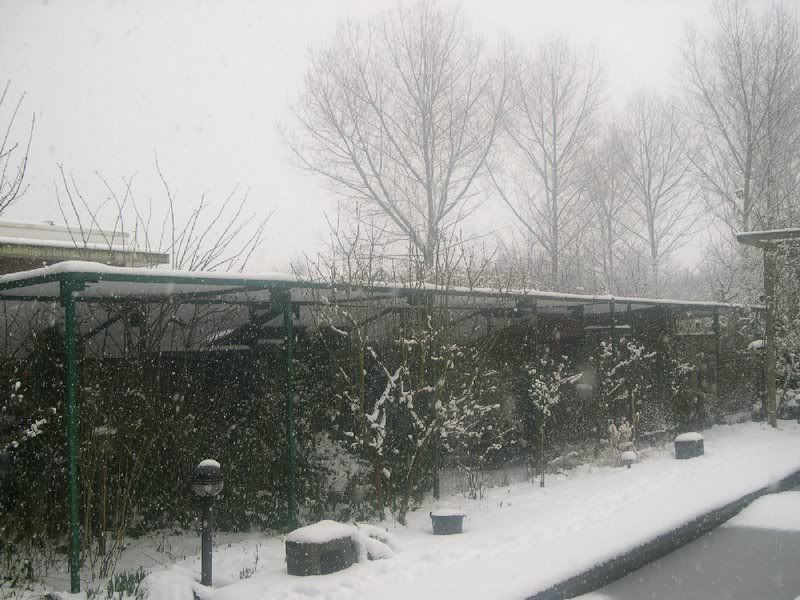
Days are short 7 to 8 hours from witch, due to the low sun, 2 hours shimmering light .
Your suggestion that Beauty lacks time to eat really makes sense.
Last Oct. my couple of White crowned robin chat Cosypha albicapilla
A African bird closely related to the Shama.
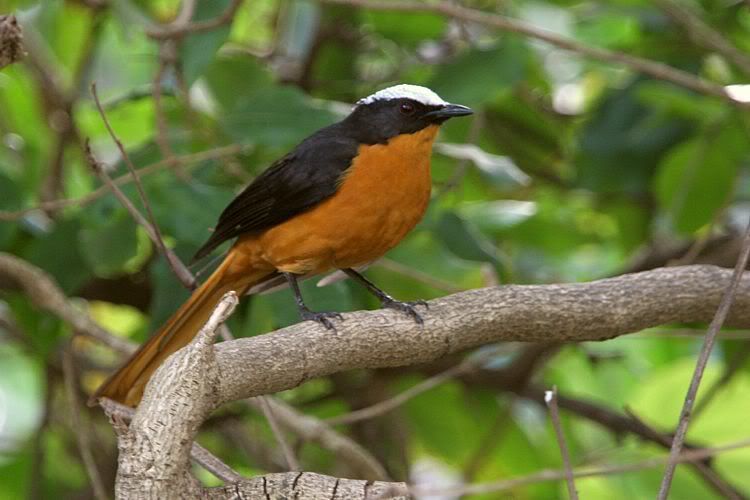
Secretly had a nest we found it (Well my wife did) 3 days before the eggs hatched. As usual we let theme fly free but because there were no
insects after 3 days they did not leave the breeding flight.
We provided 2 times a day a mixture from white mealworms crickets meat (Beef) Earthworms shrimps off course with all kinds off minerals and vitamins. They grew amazingly well and everything to our surprise looked ok.
Than after 3 weeks even a bit more they died both within 2 days.
Now I realise that was the time they had to learn eating for themselves
To less time in a day to learn and to eat.
In Spring we will relocate the Shama's to the Royal suite.
This is an impression of the greenhouse
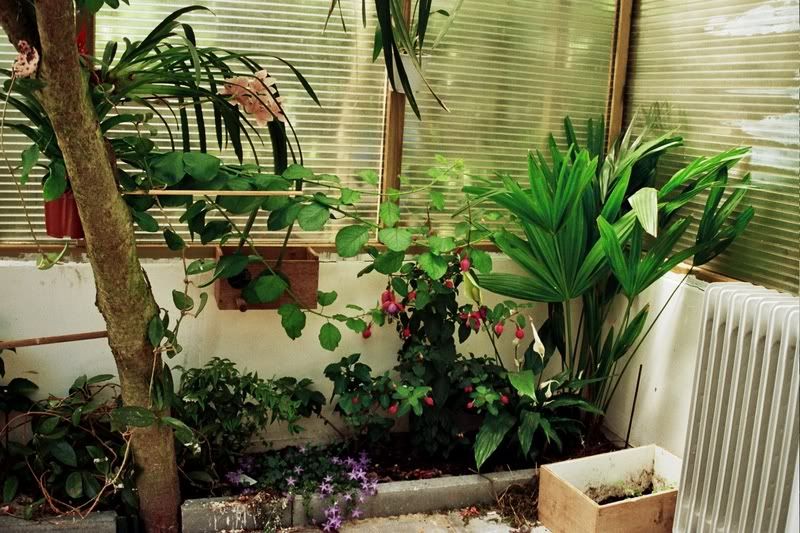
The Royal suite is acquitted with special daylight lamps and timers so they really will have the optimal conditions.
Earthworms
You are absolutely right a worm is a natural bird food and we should not be afraid for a worm on daily basis.
I only give a warning to those who read this and think worms are good Uncle David says so and I have plenty off worms.
Because then there is a problem the same as the newspaper for crickets and mealworms some regard the daily news as food for their insects.
Yes an interesting detail about the earthworm is that it is at a certain time toxic that is during it's fertility period.
The earthworm has two sides in the middle is a connection section when that section is pink the worm is toxic.
Don't know or birds are aware of this fun to know item.
Sub- species of Shama
I have spend the last month hours and hours searching the internet to unravel the subspecies of the Shama and really David it's complicated
And every week new subspecies were added to the list.
I also found a map with the location of each subspecies on a Chinese site
You can see the result of my effort in the post
White-rumped Shama Copsychus malabaricus subspecies
Off course we in Holland don't have the chai where we can compare and study the different kind of Shama's so the only source for me are photos from the internet and written articles.
A photo shows a lot but does not reveille the seize of a bird and what is the reliability off the articles.
But if the map off subspecies is correct and Beauty is from Medan Sumatra his subspecies is M.c. tricolor discovered by Veillot.
The subspecies along the border Thai/Malaysia is supposed to be the
C.m. mallopercnus (Oberholser): or
C.m. interpositus (Robinson & Kloss):
But reading all the articles mostly from your hand I'm convinced their is also an large diversity in one sub specie.
Leading to some conclusions.
On one side the Shama is an very old species considered the range of it's habitat from India Burma China to the South Indo China Indonesia.
And all the Islands before the coast what about Sri Lanka?
( One question is haunting me and that is Papua New Guinea could it be in our live time they will find a Shama with a 6'tail David that would be a treat)
On the other side and that is an confirmation how old the Shama is. It's also a very territorial bird who is capable to have local chartists.
Which suggest a very flexible DNA easily changeable by habitat?
Well it's past 0.100 in winter Holland I give my thoughts about the Shama a rest.
David's Reply dated January 17, 2007
Hi Arjan,
Thank you for the very informative and thought provoking post.
The beef and chicken are fed raw. To avoid parasite infestation, care will of course have to be taken to ensure that the beef is as fresh as posssible. I offer only very lean beef to avoid the birds getting fat.
I was very interested to be informed about Uni Komplet for 2 reasons. I believe that the shama requires a high protein intake of about 30% but my birds have been getting more than this as I have been adding dried insects etc to their food for the past few months. I would like to bring down the quantity of protein in the food and I note that Uni Komplet has only 18% protein. I personally do not think that this is sufficient for the shama but it serves my purpose as, by adding it to the dry food, the overall quantity of protein will be reduced. Also, Axel Voltz has been bugging me for some time to feed fruit to my birds. His birds are doing marvellously and I have been wanting to adopt his advice and to feed some fruit but have not got down to it. As Uni Komplet has 5% fruit, the birds will at least get some.
You raise an interesting point about sub-species. I myself have never been too interested in making a study of the sub-species from various habitats for the reason that even in the same habitat the structure, character, song etc may vary greatly. Thus, shamas from central Thailand are generally smaller in size and have longer tails than those in southern Malaysia but there are shamas in central Thailand that cannot be distinguished from the Malaysian birds. Now, if the shamas from a certain area constitute a true sub-species, the experts should be able to recognise all the birds in a particular area as belonging to the same sub-species and can tell that a bird belongs to that sub-species merely by examining one. I will bet you anything that I can produce, lets say, 10 birds, supposedly belonging to different sub-species, and the scientist will be unable to distinguish the sub-species to which they are supposed to belong.
In other words, as you note, the sub-species may just be habitat sensitive. I agree. The structure, song and character of the birds are determined more by the type of terrain than by the mere geographical location. Thus, in areas where food is plentiful, the shamas tend to be larger and "lazier" than those in areas where food is more difficult to procure. In the latter areas, the need to roam over a larger area for food results in a slimmer bodied bird which is more active and aggressive in defending its territory. However, if such a bird is then moved to an area where food is plentiful, over a relatively short time his progeny will look like all the other birds in the area.
Let's take an example of the English Cockney. We can tell his origins from his accent and from his manerisms. However, if he goes to Cambridge and picks up the Cambridge accent and the mannerisms of the educated Englishman, even the expert may be unable to tell his origin. It is the same with the shama. Because of this, there is a saying amongst shama hobbyists in this region that it does not matter where a bird comes from so long as it is a good bird. Having said this, it is a fact that some regions tend to be more likely to produce the type of bird that we in this region consider desirable. Thus, shamas from the island of Langkawi in northern Malaysia/Thailand birds are favoured by many hobbyists as birds with long tails are more likely to be obtainable from this area.
There are birds from only 2 habitats that I would consider to be sub-species. This is because if they are bred type to type you will get birds with the same distinguishing characteristic. First is the white-capped shama from Borneo. It looks identical to the white-rumped shama except that it has a white patch on the crown of its head. This sub-species is found in Borneo and nowhere else. A friend once imported a shipment into Singapore and my friend Michale Leong each took a pair. We gave the birds away after awhile as the song and display were not desirable.
The other sub-species is the shama with all black tails. From time to time, they are imported into Singapore. These birds have very short tails of 3" to 4" but they have great variety in their song and are desirable as songsters. I once had a male with about 11" inch all black tails whose song I expected to be as good as the short black-tailed shamas. I wanted to breed the all black-tailed shamas but gave up the idea after I had kept him for a few days and found that his song was lacking in variety. I do not know if he was a good example of the long black-tailed shamas.
Warm regards,
David
No comments:
Post a Comment